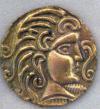How Gecko Feet Got Sticky

How do key innovations in the animal kingdom arise? To explore this question, gecko expert Timothy Higham, an associate professor of biology at the University of California, Riverside, led a team of evolutionary biologists to study Gonatodes, a genus of dwarf geckos. In the process, the researchers found a gecko,Gonatodes humeralis, that they posit offers a “snapshot” into the evolution of adhesion in geckos.
Credit: Higham Lab
Credit: I. Pittalwala, UC Riverside
“The relatively simple adhesive system of the G. humeralis is indicative that slight modifications in form can dramatically influence functional outcomes and the ecological niches that can be exploited,” Higham said. “This ostensibly padless gecko offers us a snapshot – a crucial intermediate stage – of the evolution of the adhesion apparatus. It’s telling us, ‘Look, this is how pad-bearing geckos started to acquire adhesion.’”
Further, the findings indicate that the origin of adhesion in geckos was gradual and led to major shifts in ecology and function. They suggest, too, that subtle morphological changes are able to trigger rapid evolution.
Study results appear Sept. 29 in theBiological Journal of the Linnean Society.
The setae of G. humeralis are short and simple compared to those of pad-bearing geckos, such as tokay geckos. The setae are located adjacent to friction-enhancing “spinules” – small projections, which play no role in adhesion, that are found underneath the feet of many lizards and geckos. The authors argue that the setae of G. humeralis result from a transformation of the spinules.
“Until now, we had not seen a gecko showing the beginnings of the adhesive system,” Higham said. “In all the innovations seen in the animal kingdom, we rarely get to see their beginnings. Our findings serve as good evidence against intelligent design ideas. Evolution takes place in incremental steps, as the ‘snapshot’ we report on shows. Complexity does not start with complexity. Small modifications can, however, lead to complexity. Key innovations can come about in small incremental steps and lead to feedback processes that result in the more complex renditions of such systems. Our research offers more experimental evidence to show this is true.”
Higham and his colleagues found G. humeralis specimens in Trinidad and French Guiana. They first used scanning electron microscopy to examine the microanatomy underneath the geckos’ toes and morphometrics to compare them to close relatives. After these initial observations, the team studied this species and others in the laboratory using a combination of high-speed video to measure locomotion and force transducers to quantify clinging ability, finding that only G. humeralis could generate clinging force and climb vertical smooth acrylic.
“Our work would interest researchers in nanotechnology and biomimicry because it explores the question: ‘What are the minimum structural modifications to enable adhesion?’ Gecko-inspired robots tend to have fully developed adhesion systems. But is that necessary? Our work suggests that not much is needed to get a good adhesion system going, and may therefore help simplify how we approach biomimicry and how we recreate adhesion in the lab.”
Higham’s coauthors on the research paper are Tony Gamble at Marquette University, Milwaukee, Wisc.; and Anthony P. Russell at the University of Calgary, Calgary, Canada.
Funding was provided by a National Science Foundation grant to Higham and a Natural Sciences and Engineering Research Council of Canada Discovery grant to Russell.
Iqbal Pittalwala
University of California, Riverside
Source: http://www.ineffableisland.com/2016/09/how-gecko-feet-got-sticky.html
Anyone can join.
Anyone can contribute.
Anyone can become informed about their world.
"United We Stand" Click Here To Create Your Personal Citizen Journalist Account Today, Be Sure To Invite Your Friends.
Please Help Support BeforeitsNews by trying our Natural Health Products below!
Order by Phone at 888-809-8385 or online at https://mitocopper.com M - F 9am to 5pm EST
Order by Phone at 866-388-7003 or online at https://www.herbanomic.com M - F 9am to 5pm EST
Order by Phone at 866-388-7003 or online at https://www.herbanomics.com M - F 9am to 5pm EST
Humic & Fulvic Trace Minerals Complex - Nature's most important supplement! Vivid Dreams again!
HNEX HydroNano EXtracellular Water - Improve immune system health and reduce inflammation.
Ultimate Clinical Potency Curcumin - Natural pain relief, reduce inflammation and so much more.
MitoCopper - Bioavailable Copper destroys pathogens and gives you more energy. (See Blood Video)
Oxy Powder - Natural Colon Cleanser! Cleans out toxic buildup with oxygen!
Nascent Iodine - Promotes detoxification, mental focus and thyroid health.
Smart Meter Cover - Reduces Smart Meter radiation by 96%! (See Video).





